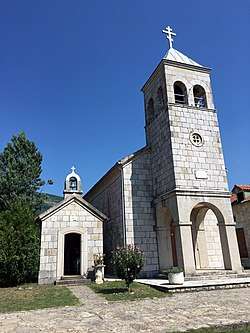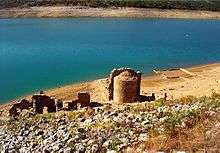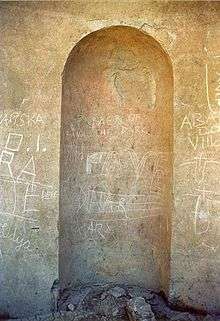Dragović monastery
Monastery Dragović (Serbian: Манастир Драговић / Manastir Dragović) is a Serbian Orthodox monastery situated on a hill downstream the Cetina River not far from Vrlika in Croatia. When the artificial Peruća Lake was created, the original monastery sank due to land movement. The new monastery Dragović was built on a hill not far from the previous one.
Манастир Драговић Manastir Dragović | |
 Dragović monastery | |
| Monastery information | |
|---|---|
| Order | Serbian Orthodox |
| Site | |
| Location | Vrlika, Croatia |
| Visible remains | Saint Grigorije Nemanjić relics |
| Public access | Yes |
History
Serbs, settled from Bosnia, built the Dragović Monastery in 1395.[1] It was built on the request of Bosnian King Tvrtko I Kotromanić, who significantly expanded Bosnia's borders (to their largest of the pre-Ottoman era), and it was meant to be the first Bosnian Bogomil church in newly acquired territories. However, the vicinity of Split parish and that of its bishop influenced church faith, which eventually resulted in the transformation to a catholic church and monastery. After the Ottoman occupation of Bosnia and south Dalmatian proper, the building soon changed hands and became an orthodox church and monastery.

In 1480 the Ottoman Turks invaded the region, raided the monastery, and expelled its residents. For full twenty years it was abandoned, until restored and renewed. Forced by the hard times of Ottoman-conquered southern Croatia with lack of supplies, five monks left to Hungary and founded Monastery Grabovac in 1555. In 1590, a year of famine, the monks abandoned Dragović and all spent the year in Grabovac. It was deserted again, this time for seventy years.
Bishop Nikodim Busović renewed the entire monastery in 1694. However, only 4 years afterwards the Ottoman Turks made another breakthrough into the region and the monks found refuge in Venetian territory. The Venetian government secured them a resting place in the village of Bribir with good lands for a new monastery, where they built a small church. The Venetians also gifted the monks community with 50 acres (200,000 m2) of land around Kistanje. In 1699 according to the Treaty of Karlowitz the Ottomans lost most of southern Croatia, so the monks were free to return to Dragović. Soon Bishop Nikodim died, and their Church in Bribir was taken over by the Venetians for Roman Catholic services.
The grounds on which Dragović rested was highly unstable and this, together with increasing moisture, convinced the monks to move the monastery to a better location. With Venetian permission, in 1777 hyeromonk Vikentije Stojisavljević began to build the new monastery in the Vinogradi. The monastery's reconstruction was very long and financially exhausting, until prior Jerotej Kovačević finally supervised its completion. It eventually opened on 20 August 1867.
Recent history

In 1959, when the artificial lake for the hydroelectric power station Peruća had been made by the Yugoslav Communists, monastery Dragović was moved on a hill not far from the old fortress called Gradina.
Between 1991 and 1993, during the Croatian War of Independence, the monastery was broken into several times,[2] and in 1995 it was abandoned, after which the church was devastated and desecrated, making it uninhabitable.[3] Later, Bishop Fotije gave his blessing to Father Đorđe Knežević to begin with the reconstruction of the monastery. In autumn 2004, basic conditions were achieved for the return of monks. Thus with the decree of Bishop Fotije, on 15 September 2004 monastery Dragović received a new brotherhood, and hieromonk Varsonufije (Rašković) was appointed their Father Superior. On the same day due to the feast of the Nativity of the Theotokos, the first Holy Hierarchal Liturgy was served in the reconstructed monastery’s church.
In this way, the tradition of the gathering of Orthodox in this monastery has been established again. This assembly occurs every year on Sunday before the feast of the Nativity of the Theotokos.
Treasury
Monastery Dragović used to have a rich treasury, in which was kept a number of manuscripts from 16th-18th centuries, as well as very old books written in Greek, Latin, Italian, Russian and Church Slavic.
There were also very rare antimens, among which was one made by Hristofor Zefarović dating from 1752. A great number of sacral objects mainly made in silver granulation and filigree from the 18th century were also a part of this rich treasury.
In the monastery’s church, a part of Saint Gregory’s relics was kept - Saint Gregory was a Serbian enlighter and Archbishop who was allegedly a descendant of Saint Nemanjić family.
Gallery
See also
- List of Serb Orthodox Monasteries
- Serbs of Croatia
References
- Ratko Jelić (1971), Almanah: Srbi i pravoslavlje u Dalmaciji i Dubrovniku, Savez udruženja pravoslavnog sveštenstva SR Hrvatske, p. 12
Срби, досељени из Босне, саградили су на Цетини манастир Драговић (1395).
- "Archived copy". Archived from the original on 2009-12-09. Retrieved 2011-04-18.CS1 maint: archived copy as title (link)
- http://www.eparhija-dalmatinska.hr/Images/Manastiri/DIG_IZDANJA/Manastir%20Dragovic.pps





